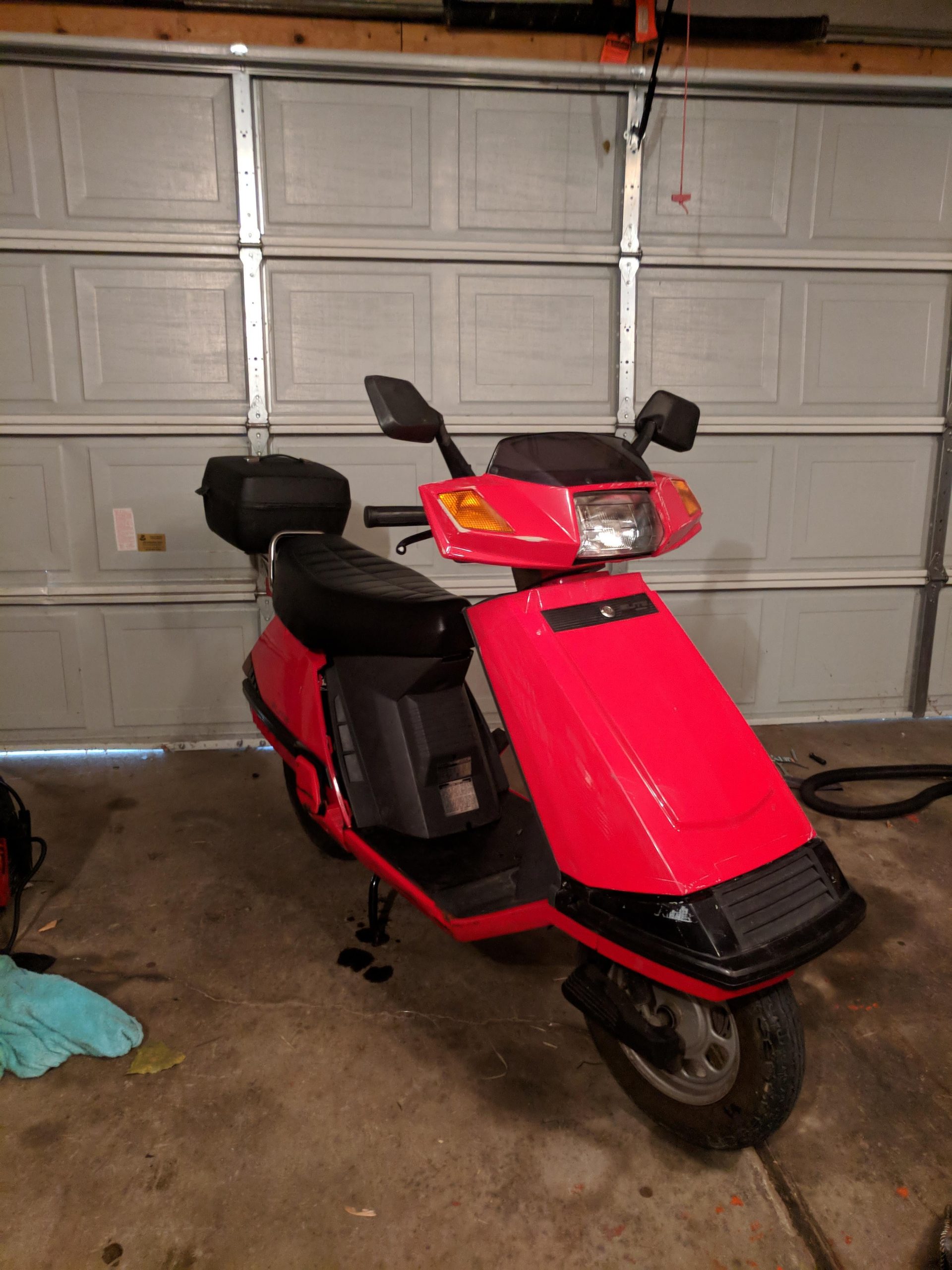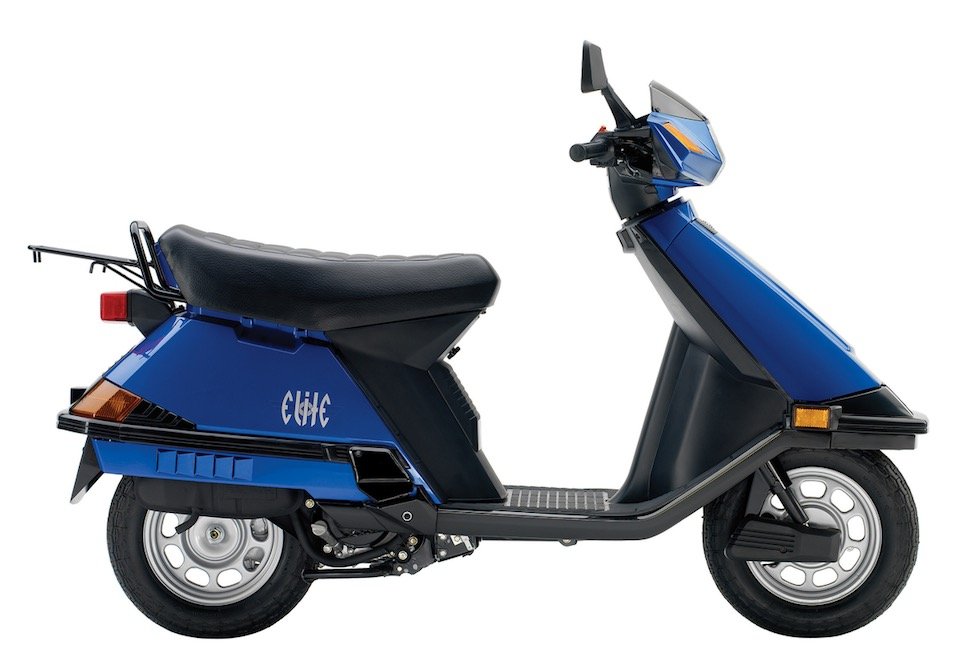HONDA ELITE 80 (CH80)
Honda introduced the 4-stroke Elite 80 (model code CH80) in 1985 as the eventual successor to their 2-stroke Aero 80. Honda had released an entirely 2-stroke line up of scooters in ’83 when it entered the North American market, but increasingly stringent emissions regulations prevented Honda from selling 2-strokes larger than 50cc for very long. In 1984 Honda released its first 4-stroke modern scooter, the Elite 125, and then released both larger (Elite 250) and smaller (Elite 80) siblings for 1985.
During the 1985 model year, the Elite 80 was sold alongside Honda’s Aero 80, but for ’86 the Aero 80 was dropped and the Elite 80 left to stand on its own against Yamaha’s 2-stroke Beluga / Riva 80 (which lasted until ’87). The Elite 80 was quite a successful scooter and it enjoyed a remarkable run from 1985 all the way to 2007. That’s an impressive 23 model years with virtually no changes. It’s almost as if Honda kept this scooter around just to outlast Yamaha’s Riva 125 (1985 – 2006).
Model Changes
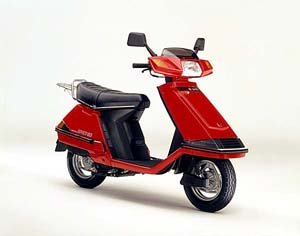
Engine
Honda’s Elite 80 contains an extremely nice scooter engine. It’s not because of the technology, it’s a pretty standard 2-valve, air-cooled 4-stroke engine. The reason this engine is great is because it small yet powerful and it runs smoothly and reliably all day at full throttle. It never sounds like it’s working hard, and it makes a solid amount of power for scootering around town. You won’t be doing wheelies with this scooter but you won’t be frustrated off the line either like you can be with some 50cc 4-strokes. When you twist open the throttle the Elite 80 pulls solidly and predictably to its top speed of 45mph. You get the power of a 50cc 2-stroke engine in a quieter, more reliable and more fuel efficient 4-stroke package.
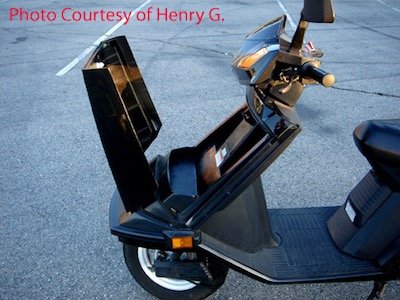
Aftermarket Scene
Despite the Elite 80’s popularity and long model run, an aftermarket scene never really developed for this scooter. Battlescooter did briefly produce an exhaust for this scooter but besides that there really isn’t anything Elite 80 specific. Most aftermarket scooter parts are created in Japan and Taiwan and the Elite 80 was never that popular over there which is why there aren’t go fast parts available. Until recently, the Japanese and Taiwan folks have seemed to focus on only 2-stroke scooters and mostly 50cc ones at that.
Storage & Convenience
Compared to the Aero 80 that it replaced, the Elite 80 offers a bit less storage space. The front ‘trunk’ of the scooter gives you enough storage to stow a windbreaker or a couple cans of pop but that’s about it. The Aero 80 could hold at least this much stuff in its easier to access glovebox, plus the ’85 Aero 80 had a nice storage compartment in the side panel that you could toss your lunch in. As a side note, the stylistically updated ’85 Aero 80 appears to share an identical rear end as the Elite 80.
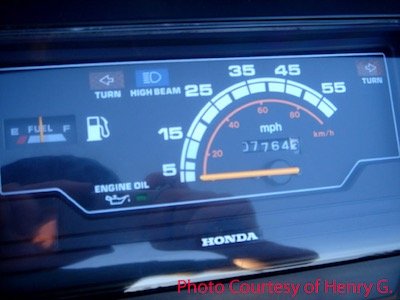
Discussion
There are a few downsides to the Elite 80 which are good to know about. First, the CH80 doesn’t have a fuel filter. I’ve seen people left stranded because crud from a rusty fuel tank collected in the carb and clogged the main jet. Anyone with an Elite 80 should spend $5 on a universal fuel filter and then snip your filter line and slip this in. This is especially important if you’re getting an Elite 80 running after several years of sitting and it might have some grub in the tank.
Secondly, the Elite 80 loves to snap exhausts where the header pipe meets the muffler. The design simply fatigues over time and fails, so there’s not much you can do about it short of reinforcing it beforehand, or buying the aftermarket Battlescooter exhaust.
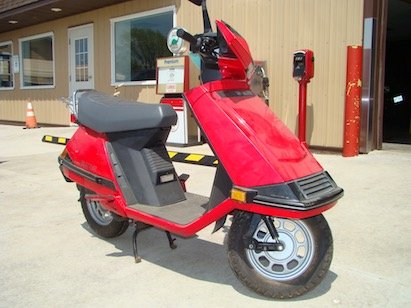
Minor complaints aside, the Elite 80 is a very well engineered scooter. It’s got a cool indicator on the dash that lets you know when it’s time to change the oil. This indicator is based purely on milage though and is not an indicator of actual oil quality. The indicator flips from green to red whenever the oil change interval milage has been driven. Compared to my old Yamaha CV80, everything seems very well thought out. The body panels pop off nicely when working on the scooter. The seat is large and quite comfortable. The Elite 80 has nice large passenger pegs, the rear rack is chromed. It’s quality stuff. There’s a reason this scooter was sold for over 20 years with barely any changes. If legislation didn’t encourage 50’s, Honda would have sold a lot more still.
Pros:
- Great Reliable Engine
- Fuel Milage (~75 – 80mpg)
- Loads of OEM / NOS parts available.
Cons:
- Minimal amount of storage
- Lacks fuel filter and kickstarter
- Few aftermarket parts
Links:
Elite 80 Service Manual – Great info for the DIYer.
MotorscooterGuide Forums – Visit the forums
JacksScooterShop – Maintenance chart
Motorera Elite 80 – Nice info on yearly tweaks
Key Specs:
- Engine: 79.9cc single cylinder, air-cooled, 2-valve, 4-stroke
- Bore & Stroke: 49.5mm x 41.4mm
- Compression Ratio: 9.3:1
- Spark Plug: CR7HS (NGK) or USSFSR-U (ND)
- Fuel system: 16mm Carburator
- Cooling system: Air
- Ignition: CDI
- Transmission: V-Belt with 8.382:1 final reduction
- Gear Range: 1.08 to 2.70:1
- Alternation: 100 watt @ 5000 RPM
- Seat height: 754 mm (29.7 inches)
- Wheelbase: 1,171 mm (46.1 inches)
- Front suspension travel: 76 mm (3.0 inches)
- Rear suspension travel: 79 mm (3.1 inches)
- Brakes: Drum / Drum
- Tires: 3.5 x 10.0 (front and rear)
- Weight: 172 lbs
- Fuel capacity: 5 litres (1.30 gallons)
- Fuel Milage: 75-80 mpg
Colors:
- 1985 – Luminous Red, Cortina White
- 1986 – Luminous Red, Shasta White
- 1987 – Luminous Red, Capri Blue
- 1988 – Luminous Red, Black
- 1989 to 1990 – Ross White, Nassau Blue Metallic
- 1991 to 1993 – Monza Red
- 1994 – Monza Red, Gloss Black
- 1995 to 2000 – Shasta White, Gloss Black
- 2001 – Gloss Black, Pearl Rio Yellow
- 2002 – Shasta White, Gloss Black, American Red
- 2003 – Shasta White, American Red
- 2004 – Shasta White, Gloss Black, Pearl Rio Yellow, American Red
- 2005 – American Red, Starlight Silver Metallic
- 2006 – American Red, Pearl (aka Twister) Blue
- 2007 – American Red, Tornado Gray Metallic

